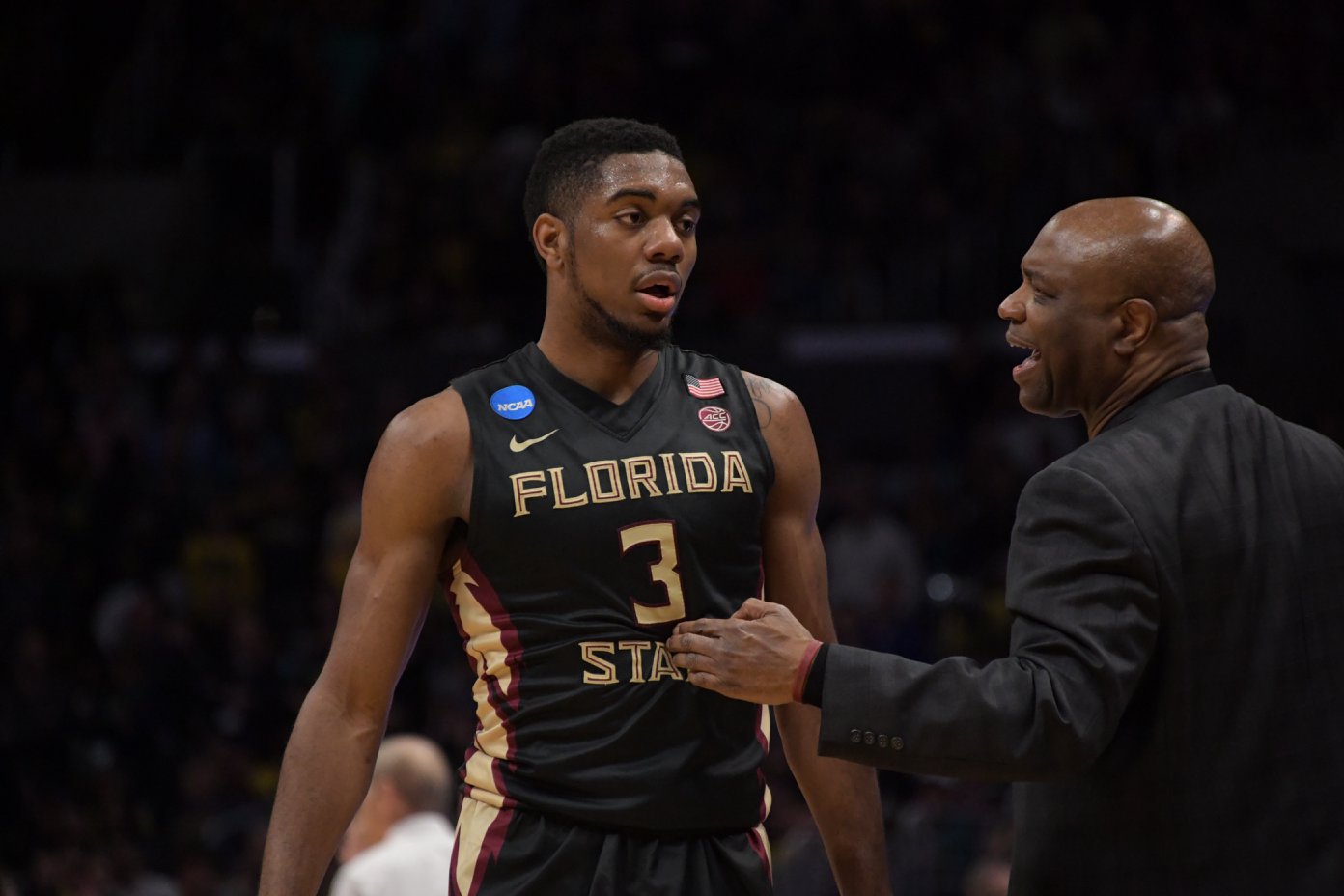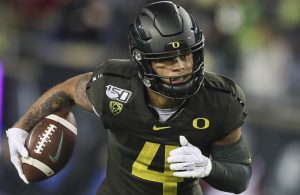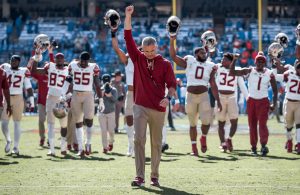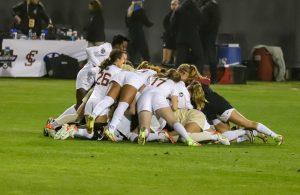- Sunday Seminole Summary: FSU Football Adds Pair of WR Transfers
- Sunday Seminole Summary: FSU Football Exits ESD With Top-15 Class
- Sunday Seminole Summary: FSU Soccer Tops BYU for Third National Championship
- Sunday Seminole Summary: FSU Soccer Advances to National Championship Match
- Seminole Sunday Summary: FSU Soccer Heads Back to College Cup
- Seminole Sunday Summary: FSU Soccer Reaches Sweet 16; Football Tops Boston College
- Seminole Sunday Summary: FSU Soccer Wins ACC, Advances to Second Round of NCAA Tournament; FSU Football Rallies Past Miami
- Seminole Sunday Summary: FSU Soccer Tops Wake on OT to Advance to ACC Final
- Seminole Sunday Summary: FSU Football Crushes UMass for Third Straight Win
- Seminole Sunday Summary: FSU Soccer Stays Perfect with Pair of Wins
How Leonard Hamilton Set Up FSU Basketball for the Future
- By Clint Eiland
- Updated: March 25, 2018
 Kirby Lee/Image of Sport
Kirby Lee/Image of SportAt one point, Florida State basketball was two games from the national championship.
The sting of a close loss to the Michigan in the Elite Eight will linger for a while. A ninth-seeded bubble team made an improbable/incredible run where it beat three higher-ranked teams, including powerhouses like Xavier and Gonzaga.
The Seminoles had not played at that high a level since before Christmas break. But when it mattered most, they rallied around each other and turned in three stunning performances.
Fans will be even more delighted to hear the good news: thanks to head coach Leonard Hamilton’s roster management, Florida State is set to make noise in the ACC and possibly repeat this tournament run next season.
Except this time, it might be expected.
The Seminoles return eight players who received more than 10 minutes per game for the 2017-18 season. That includes second-leading scorer and top rebounder Terance Mann, leading shot blocker Ike Obiagu, and two players who started more than 20 games in center Christ Koumadje and guard C.J. Walker. Only Braian Angola, Brandon Allen, and Phil Cofer are expected to depart in the offseason.
However that might not even be accurate when all is said and done: Cofer is looking to get another year of eligibility. His sophomore season of 2015-16 saw him suffer an ankle injury after 11 games, which is one game above the cutoff for a medical hardship. The NCAA will make a ruling sometime in the near future.
Assuming that Cofer does not receive an extra year of eligibility, Florida State will miss the scoring from both him and Angola. Then again, most assumed that the offense would take a big step back when Dwayne Bacon, Jonathan Isaac, and Xavier Rathan-Mayes all departed. Obviously things turned out pretty well for the Seminoles.
None of the aforementioned players are game-changers on the defensive side of the ball. Angola came up with some nice steals and Cofer improved as a shot blocker, but neither of them had an aspect of their defense that was indispensable. Much of the tournament run was fueled by players who will be coming back for another season.
Hamilton choosing to play Obiagu and Mfiondu Kabengele more as the season went on was a very prescient move. As a coach, you need to take into account the mental aspect of the game every time you put a player out on the court. Hamilton gradually introduced both players into the lineup in a way that helped them understand their roles.
Someone like Obiagu — who plays aggressive defense and struggles on offense — could easily get discouraged if he’s not utilized properly. Instead, he became an absolute defensive force that reckons to be one of the premier shot blockers in college basketball next season. The same principle goes for Kabengele and his developing offensive game.
It’s icing on top of the cake that these same guys got the experience of playing against more challenging opponents in the tournament. That’s not to say the ACC games didn’t help immensely, but any time you can get your feet wet in a tournament environment helps. Especially when it’s elite teams like Xavier and Gonzaga.
Hamilton speaks a lot about maturity when discussing players. Maturity encompasses a variety of factors, which include attitude, on-court experience, basketball IQ, and more. It showed in the tournament that multiple guys took his lessons to heart and matured as basketball players.
They fully committed to the system and played three of the best games of the season. Even the loss to Michigan had a lot to be proud of, like a revitalized defense that would have folded at some points during the regular season.
There’s no reason to doubt that Florida State will roll out a more “traditional” rotation next year. It will have at least three experienced post players in Koumadje, Obiagu, and Kabengele to work with. The former two will shoulder more of the defensive load while Kabengele can focus a bit more on scoring. Compare this to the beginning of the season when the Seminoles had just Koumadje as a “proven” factor.
If we are still assuming that Cofer doesn’t come back, it does raise the question of who fills in the stretch forward responsibilities. Teams don’t actually need a stretch forward, but it can only help to have variety in an offensive approach.
The Seminoles do have one player of interest in this regard: Raiquan Gray. Followers of basketball recruiting will remember Gray from the 2017 cycle. He’s a 6-foot-8, 250-pound forward out of Fort Lauderdale who can threaten from all three levels of the court. He redshirted this year for development reasons and an already deep bench.
Gray might be more natural of a shooter than Cofer was at this point of their careers, so it would not be surprising if Gray started to rotate in as the season goes along. He probably won’t get the minutes that Kabengele and Obiagu were, simply because the Seminoles won’t actually need that much more depth down low. He still brings a unique mix of skills that Hamilton can toy with.
There’s a bit of a guessing game beyond that with how the backcourt will look. Terance Mann is the one secure starter, with a mix of Trent Forrest, P.J. Savoy, and M.J. Walker all vying for starting spots. In the end it probably won’t matter much, because the Seminoles will have a lot of flexibility with how they approach various games. Walker only started one game this year but he was obviously a huge part of the team’s strategy.
Another possibility is that Forrest stays as a sixth man who regularly gets 20 or more minutes per game. He and Mann have a similar game, but Forrest is the more athletic of the two. Mann gives a bit more defensively and he’s more experienced.
M.J. Walker’s development will be crucial. As arguably the most talented player on the roster (and the highest ranked from a recruiting standpoint) Walker disappeared down the stretch. He was never going to light up the world in his freshman season, but his complete collapse in the tournament was discouraging.
Hamilton realized by the Sweet 16 contest with Gonzaga that Walker was a bit overwhelmed by the stage, and thus he received only eight minutes in the loss to the Wolverines. His final tournament stats: 10 points on 3-for-18 shooting, seven rebounds, and four assists. To his credit, he did spur a defensive turnaround in that Michigan game with three steals. But that was quite literally the one bright spot of his tournament.
Walker needs to do more than be a 3-point specialist. He’s shown himself to be a better player than that, especially with the tools at his disposal. How Hamilton develops him will be the key for a repeat performance next season. If Walker can diversify his scoring approach, his contributions to the team could be immense.
The days of the “junkyard dog” defense are probably never coming back. But after the recent results, can anyone say that’s a bad thing? Hamilton changed his approach to both on-court strategy and recruiting in a way that promotes consistency from year to year.
With his previous system, the highs and lows were often dependent on how many veterans were in the system. That’s no longer the case. The Seminoles can lose multiple starters and still forge an identity with the players that returned.
Having guys like Forrest or Walker that can grow as athletes means that the team has more options when the next season rolls around. Player development has truly benefited Florida State in a way that speaks very highly of Hamilton and staff. They’re not perfect, and some players may not have been maximized (Jonathan Isaac), but overall they’ve done a fantastic job.




You must be logged in to post a comment Login